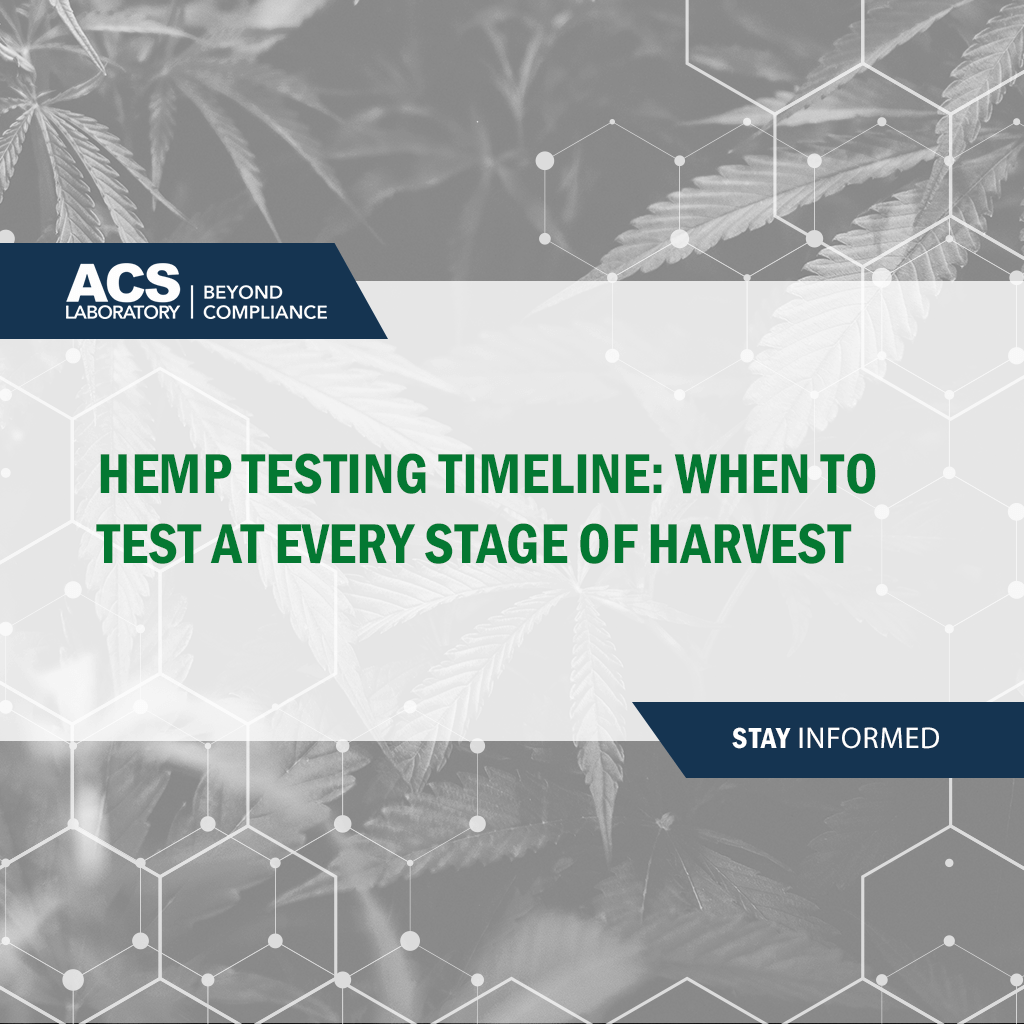Unexpected Cannabis Viruses: Risks, Prevention, and Laboratory Testing
By Roger Brown, ACS Laboratory President

In this post:
- Common cannabis viruses
- How viroids affect cannabis crops
- How viral contamination occurs
- Cultivation prevention tips
- Laboratory testing tips
The cannabis industry has experienced explosive growth in recent years. Retail sales crested $1.2 billion in 2018, and projections estimate they’ll reach $2.5 billion by 2022. However, as we enter the era of mass production, unexpected crop loss is also on the rise. Cannabis growers have noticed curious viral symptoms, and they’re seeking help from third-party labs like ACS Laboratory to combat the threat.
Pesticides and mold are still the most common cannabis contaminants; however, viruses such as hop latent viroid, lettuce chlorosis virus, and cannabis cryptic virus are highly damaging and more typical than you think. Cultivators must be aware of these pathogens and learn about the latest prevention tactics to stop cannabis viruses from running rampant through their crops.
Thankfully, advanced laboratory testing is readily available and the most effective means to keep crop health in check. Here’s what we know about the potential causes of viral cannabis contamination, early detection methods, and what growers can do to stop viruses before they spread.
Cannabis Viruses That Cause “Dud” Plants
“Dud” crops perplex cannabis growers more frequently these days, and scientists have identified three main viruses behind the mysterious symptoms:
- Hop latent viroid
- Lettuce chlorosis virus
- Cannabis cryptic virus
Hop latent viroid (HLVd), sometimes referred to as “dudding” or the “dudding disease,” is a single-stranded, circular infectious RNA virus that depends entirely on the host plant’s metabolism for replication, causing it to affect the host’s cells negatively. Although first identified in the hop plant, hop latent viroids also infect cannabis—a hops relative—with more severe effects.
The cannabis industry first recognized HLVd back in 2017 when a grower in California noticed strange, sickly symptoms, including yellow leaves and brittle stems, along with reduced yields in a subset of his crop. After investigating the cause of the issue, experts discovered that viroid-carrying plants from California started rapidly spreading across the U.S as an unfortunate byproduct of the 2012 legalization wave.
Lettuce chlorosis virus (LCV), a member of the Crinivirus family, is a linear, single-stranded, positive-sense RNA virus transmitted by the sweet-potato whitefly, first occurring in lettuce plants grown in Southern California deserts. Plants infected early, including cannabis and hemp, exhibit symptoms similar to HLVd, including severe yellowing, brittleness, and stunted growth.
Cannabis cryptic virus (CCV), a member of the Partitiviridae family, is a double-stranded RNA virus first observed in Europe as early as 1941. Researchers recently identified the disease in infected cannabis plants that exhibited symptoms previously attributed to the hemp streak virus, including yellow streaks, wrinkles, and rolled leaves. Evidence suggests CCV spreads mainly through pollen and seeds.

Viral Dangers to Hemp and Cannabis Crops
Researchers believe cannabis viruses, especially hop latent viroid, are now widespread across the cannabis industry. More than 200,000 tissue tests conducted on cannabis crops across California from August 2018 until July 2021 support projections that hop latent viroid affects more than 30% of all cannabis plants in the U.S., translating to over $4 billion in annual revenue losses.
Despite hop latent viroids’ massive destruction potential, many growers still don’t know about its dangers to their crops. In addition to HLVd, LCV, and CCV cause noticeable symptoms in cannabis plants, including:
- Stunted growth
- Brittle stems
- Reduced flower mass
- Leaf malformation or chlorosis
- Reduced trichomes and oil production
- Reduced potency
- Overall loss of quality and yield
How Viroids Affect Cannabis Potency, Yield, and Appearance
Cannabis plants infected with hop latent viroid, lettuce chlorosis virus, and cannabis cryptic virus might appear smaller and distorted, with yellow, brittle leaves and branches. Because the plants grow shorter and have a tighter node spacing during infection, their buds also grow smaller and farther apart.
Unfortunately, reduced flower size and spacing issues produce crops with far fewer trichomes–the tiny plant hairs that contain cannabinoids such as THC and CBD, along with antioxidants, terpenes, and other substances that give each strain its identity.
In addition to reduced yields, the effects combine to create a massive problem that becomes evident during laboratory testing: a lack of potency. Plants infected with hop latent viroids may contain half the cannabinoid content of their healthy counterparts. Industry insiders report that some infected crops can lose 50% to 70% THC content. That translates into lost buyer contractors and significantly wasted resources.
The Dangers of Hidden Virus Symptoms
Another confounding factor with hop latent viroid is its “latent” nature and ability to lay dormant, lurking within cannabis plants and spreadly while showing no discernible symptoms. As a result, many growers are unaware that the pathogen is spreading to other plants. And once infected, only a lengthy tissue-culture process can produce a new virus-free plant.
The hidden nature of these cannabis viruses makes them especially dangerous to hemp farmers and hard to control. It will be almost impossible to detect and fully eradicate without consistent lab testing to ensure crops are safe and free of these damaging contaminants.
How Viroids Infiltrate Hemp and Cannabis Crops
The top risks for contamination that growers should be aware of include:
- Mechanical transmission: Pruning tools and scalpels serve as the most common culprits for spreading cannabis viruses from infected plants to the other plants in the yield.
- Cuttings for propagating and cloning: Hop latent viroid and lettuce chlorosis virus also commonly spread when growers take cuttings from an infected “mother” plant for cloning purposes, inadvertently initiating and speeding up the spread of pathogens that have yet to reveal any outward signs.
- Lack of proper quarantine and inspection: Growers can make an entire system vulnerable by introducing new varieties or cuttings to their production line without quarantining them first. This vulnerability also occurs when they don’t follow inspection protocols, such as disease testing to ensure that stocks are clean before planting.
- Pests: Studies show that LCV can be transmitted from plant to plant via pests, specifically the whitefly.
- Seeds: While not the primary means for transmission, research shows that seeds transmit HLVd at an approximately 8% rate. CCV transmits vertically through seeds, so breeders may want to screen plants before crossing.

Cultivation Tips to Prevent Cannabis Contamination
Today, sustainable disease management must be a top priority for growers to prevent rampant crop destruction. There are several key areas and approaches cannabis farmers should incorporate now to mitigate the risk of disease transmission, such as:
1. Keep It Clean
Implementing strict sanitation measures is vital for growers to keep cannabis viruses and contamination at bay. A plant’s vascular system is susceptible to infection with every cut, so it’s essential to use fresh, sterile blades directly from the package or consistently sterilize scissors and other pruning equipment.
Tool sanitation is a must, but keep in mind that not all disinfectants are created equal. Although the cannabis industry commonly uses alcohol mixtures for cleaning purposes, a 10% household bleach solution is the most effective way to prevent virus spread in growing operations.
2. Control Pests
Effective pest control should be a part of every grower’s strategy. Applying fungal and bacterial biological control agents can target cannabis pests such as aphids, thrips, mites, and whiteflies that transmit and widely spread viruses and other pathogens when they feed on infected plants and make their way throughout the crop.
3. Quarantine and Test
Growers must establish clean planting stock by setting up a sterile quarantine area for new arrivals. They can isolate additions or mother plants until they are confident they are not infected, especially before multiplying or cloning them.
A diagnostic screening test is the fastest way to determine the presence of a virus and the only way to be entirely sure a plant is healthy. If the test results are positive, immediately remove the infected plant from the facility. Any plants that had contact should also be quarantined and tested.
4. Test early and Often
Growers should make it part of their protocol to test mother plants and random crop samples several times per year via qualified labs regularly to double-check that they haven’t come into contact with any contaminants. Because virus symptoms can remain dormant and hidden for long periods, it’s best to be proactive and vigilant. Any suspicious-looking plants should be tested right away.
Consistent and Early Testing is Crucial
Pathogen-testing mother and young plants is critical as growers move into the 2022 season. Although the high risks associated with hop latent viroid, lettuce chlorosis, and cannabis cryptic virus are just coming onto the radar, proactive third-party laboratories have pivoted quickly to develop tests.
At ACS Laboratory, we perform pre-harvest testing for every stage of the planting process, including various contaminants and toxins. When one of our clients noticed stunted growth and suspected the possibility of viral infections, we developed a generic qPCR test to look for the presence of the hop latent, lettuce chlorosis, and cannabis cryptic viruses. We’ve been working with that grower to test its mother plants every few months to ensure they’re clean and virus-free, as well as perform spot-check testing any time they think there might be a potential contamination issue.
Hop latent viroid and other dangerous infections will only become an increasing issue across the country as more cannabis growers expand their production, whether growing hemp crops outside or in greenhouses and hoop houses. Stunted growth with declines in yield and potency can significantly impact growers' bottom lines who don’t utilize every tool at hand to combat these emerging pathogens, including proper sanitation, pest management, and routine testing.
If you want to go on the offensive against these diseases, we’re here to help your growing operation and make it easy to start testing today.




.jpg)




.png)
.png)
.png)
.png)
.png)